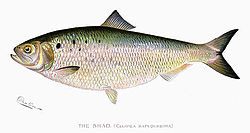American shad
| American shad | |
|---|---|
 |
|
| Watercolor of an American shad by Sherman F. Denton, 1904. The swelling between the anal fin and ventral fin identifies this as a gravid female. | |
| Scientific classification | |
| Kingdom: | Animalia |
| Phylum: | Chordata |
| Class: | Actinopterygii |
| Order: | Clupeiformes |
| Family: | Clupeidae |
| Subfamily: | Alosinae |
| Genus: | Alosa |
| Subgenus: | A. (Alosa) |
| Species: | A. (A.) sapidissima |
| Binomial name | |
|
Alosa (Alosa) sapidissima (A. Wilson, 1811) |
|
| Synonyms | |
|
Clupea sapidissima |
|
Clupea sapidissima
The American shad (Alosa sapidissima), is a species of anadromous clupeid fish naturally distributed on the North American coast of the North Atlantic, from Newfoundland to Florida, and as an introduced species on the North Pacific coast. The American shad is not closely related to the other North American shads. Rather, it seems to form a lineage that diverged from a common ancestor of the European taxa before these diversified
The American shad has been described as "the fish that fed the (American) nation's founders". Adult shad weigh between 3 pounds (1.4 kg) and 8 pounds (3.6 kg), and they have a delicate flavor when cooked. It is considered flavorful enough to not require sauces, herbs or spices. It can be boiled, filleted and fried in butter, or baked. Traditionally, a little vinegar is sprinkled over it on the plate. In the eastern United States, roe shads (females) are prized because the eggs are considered a delicacy.
The shad spends most of its life in the Atlantic Ocean, but swims up fresh rivers to spawn. Northern populations are iteroparous, thus they may survive breeding, return to the sea and then return to freshwaters to spawn several more times. However, southern populations exhibit semelparity, similar to Pacific salmon. In the marine environment, shad are schooling fish. Thousands are often seen at the surface in spring, summer, and autumn. They are hard to find in the winter, as they tend to go deeper before spawning season in the range 13–18 °C (55–64 °F); they have been pulled up in nets as deep as 65 fathoms (119 m).
Like other herrings, the American shad is primarily a plankton feeder, but will eat small shrimp and fish eggs. Occasionally they eat small fish, but these are only a minor item in their general diet.
...
Wikipedia

